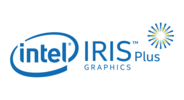Intel UHD Graphics P630 vs Intel Iris Plus Graphics 650
Intel UHD Graphics P630
► remove from comparison
The Intel UHD Graphics P630 (GT2) is a professional integrated graphics card, which can be found in various Xeon desktop and notebook processors of the Coffee-Lake generation. The "GT2" version of the GPU offers 24 Execution Units (EUs) and the clocks depend on the CPU model. Due to its lack of dedicated graphics memory or eDRAM cache, the UHD P630 has to access the main memory (2x 64-bit DDR3L-1600 / DDR4-2133). Compared to the older HD Graphics P630 (Kaby-Lake), the newer UHD GPU is identical but can be clocked slightly higher. Compared to the regular UHD 630, the P630 supports ECC main memory and is intended for professional applications.
Performance
The exact performance of the UHD Graphics P630 depends on various factors like TDP, L3 Cache, memory (DDR3/DDR4) and maximum clock rate of the specific model. However, it should be fairly similar to the HD Graphics 530 and HD Graphics 630 and therefore only suited for low demanding games like Overwatch or Farming Simulator 2017 (low details).
Features
The features of the UHD P630 are the same as for the HD 630 and therefore H.265/HEVC Main10 profile at 10-bit color depth are supported in hardware. Furthermore, HDCP 2.2 is also supported in all chips, which allows Netflix 4K videos, for instance. HDMI 2.0 however is still only supported with an external converter chip (LSPCon).
Power Consumption
The UHD Graphics P630 can be found in several notebook and desktop processors of different TDP classes.
Intel Iris Plus Graphics 650
► remove from comparison
The Intel Iris Plus Graphics 650 (GT3e) is a processor graphics card for Kaby Lake models announced in January 2017. As the successor to the Intel Iris Graphics 550 (Skylake), the Iris Plus Graphics 650 is used for 28-Watt models and is equipped with 64 MB eDRAM cache. There should not be any big changes compared to the Iris Graphics 550.
The so called GT3e version of the Kaby Lake GPU probably still has 48 Execution Units (EUs), which can reach up to 1100 MHz depending on the model. Besides eDRAM cache, the Iris 650 can also access the system memory (2x 64 Bit DDR3L-1600/DDR4-2400) via processor interface.
Compared to the Iris Plus 640 from the 15-Watt models, the Iris 650 only has a slightly higher maximum clock as well as almost twice the TDP, which allows a better utilization of the Turbo Boost potential.
Performance
The exact performance of the Iris Plus Graphics 650 depends on the CPU model, because maximum clock as well as the size of the L3 cache can differ a bit. The system memory (DDR3/DDR4) will influence the performance as well.
The fastest chips are high-clocked Core i7 models like the Core i7-7567U. Depending on the game, the Iris Plus 650 will probably be on par with a dedicated GeForce 930M and can handle smooth gameplay in modern titles in low up to medium settings.
Features
The reworked video engine now fully supports hardware decoding of H.265/HEVC videos. Contrary to Skylake, however, Kaby Lake can now also decode H.265/HEVC Main 10 with a 10-bit color depth as well as Google's VP9 codec. The video output is possible via DP 1.2/eDP 1.3 (up to 3840 x 2160 @60 Hz), whereas HDMI is also supported in the older 1.4a standard. An HDMI 2.0 output can be added via converter from DisplayPort. The GPU can drive up to three displays simultaneously.
Power Consumption
The Iris Plus Graphics 650 is used for 28-Watt processor and therefore medium-sized notebooks.
| Intel UHD Graphics P630 | Intel Iris Plus Graphics 650 | |||||||||||||||||||||||||||||||||||||||||||||||||||||||||||||||||||||||||||||||
| Gen. 9.5 Series |
|
| ||||||||||||||||||||||||||||||||||||||||||||||||||||||||||||||||||||||||||||||
| Codename | Coffee-Lake-GT2 | Kaby Lake GT3e | ||||||||||||||||||||||||||||||||||||||||||||||||||||||||||||||||||||||||||||||
| Architecture | Gen. 9.5 | Gen. 9.5 Kaby Lake | ||||||||||||||||||||||||||||||||||||||||||||||||||||||||||||||||||||||||||||||
| Pipelines | 24 - unified | 48 - unified | ||||||||||||||||||||||||||||||||||||||||||||||||||||||||||||||||||||||||||||||
| Core Speed | 300 - 1200 (Boost) MHz | 300 - 1100 (Boost) MHz | ||||||||||||||||||||||||||||||||||||||||||||||||||||||||||||||||||||||||||||||
| Memory Bus Width | 64/128 Bit | 64/128 Bit | ||||||||||||||||||||||||||||||||||||||||||||||||||||||||||||||||||||||||||||||
| Shared Memory | yes | yes | ||||||||||||||||||||||||||||||||||||||||||||||||||||||||||||||||||||||||||||||
| API | DirectX 12_1, OpenGL 4.4 | DirectX 12_1, OpenGL 4.4 | ||||||||||||||||||||||||||||||||||||||||||||||||||||||||||||||||||||||||||||||
| technology | 14 nm | 14 nm | ||||||||||||||||||||||||||||||||||||||||||||||||||||||||||||||||||||||||||||||
| Features | QuickSync | QuickSync | ||||||||||||||||||||||||||||||||||||||||||||||||||||||||||||||||||||||||||||||
| Date of Announcement | 01.10.2017 | 03.01.2017 | ||||||||||||||||||||||||||||||||||||||||||||||||||||||||||||||||||||||||||||||
| Memory Type | DDR4 |
|
| ||||||||||||||||||||||||||||||||||||||||||||||||
Benchmarks
Cinebench R15 OpenGL 64 Bit + Intel Iris Plus Graphics 650
Average Benchmarks Intel Iris Plus Graphics 650 → 0% n=0
* Smaller numbers mean a higher performance
1 This benchmark is not used for the average calculation
Game Benchmarks
The following benchmarks stem from our benchmarks of review laptops. The performance depends on the used graphics memory, clock rate, processor, system settings, drivers, and operating systems. So the results don't have to be representative for all laptops with this GPU. For detailed information on the benchmark results, click on the fps number.

Dirt 4
2017
Rocket League
2017
Prey
2017
For Honor
2017
Dishonored 2
2016
Titanfall 2
2016
Farming Simulator 17
2016
Battlefield 1
2016
Civilization 6
2016
Overwatch
2016
The Division
2016
Far Cry Primal
2016
Rainbow Six Siege
2015
Dota 2 Reborn
2015
The Witcher 3
2015
GTA V
2015
BioShock Infinite
2013| Intel UHD Graphics P630 | Intel Iris Plus Graphics 650 | |||||||||||||
|---|---|---|---|---|---|---|---|---|---|---|---|---|---|---|
| low | med. | high | ultra | QHD | 4K | low | med. | high | ultra | QHD | 4K | |||
| Dirt 4 | 64 | 21.3 | 14.2 | |||||||||||
| Rocket League | 113 | 56.8 | 38.9 | |||||||||||
| Prey | 51.4 | 20.2 | ||||||||||||
| Mass Effect Andromeda | 25.8 | 10.5 | ||||||||||||
| Ghost Recon Wildlands | 17.6 | |||||||||||||
| For Honor | 39.7 | 15.2 | ||||||||||||
| Dishonored 2 | 15 | |||||||||||||
| Call of Duty Infinite Warfare | 32.4 | |||||||||||||
| Titanfall 2 | 54.1 | 37.9 | ||||||||||||
| Farming Simulator 17 | 36.8 | 19.9 | ||||||||||||
| Battlefield 1 | 46.1 | 29.5 | ||||||||||||
| Civilization 6 | 42.2 | 20.2 | ||||||||||||
| Deus Ex Mankind Divided | 19.2 | 14.6 | 8.2 | |||||||||||
| Overwatch | 79.2 | 57.4 | 25.6 | 21.4 | ||||||||||
| The Division | 30 | |||||||||||||
| Far Cry Primal | 32 | 15 | ||||||||||||
| Rise of the Tomb Raider | 25.9 | 18.3 | ||||||||||||
| Rainbow Six Siege | 54.2 | 35.6 | 20.8 | |||||||||||
| Dota 2 Reborn | 95 | 64 | 29.7 | 25 | ||||||||||
| The Witcher 3 | 21.4 | |||||||||||||
| GTA V | 56.5 | 49.9 | 11.6 | 5 | ||||||||||
| BioShock Infinite | 84 | 54.4 | 46.5 | 13.3 | ||||||||||
| Intel UHD Graphics P630 | Intel Iris Plus Graphics 650 | |||||||||||||
| low | med. | high | ultra | QHD | 4K | low | med. | high | ultra | QHD | 4K | < 30 fps < 60 fps < 120 fps ≥ 120 fps | | | | | | | < 30 fps < 60 fps < 120 fps ≥ 120 fps | 6 10 5 | 9 6 1 | 6 3 | 5 | | |
For more games that might be playable and a list of all games and graphics cards visit our Gaming List

















